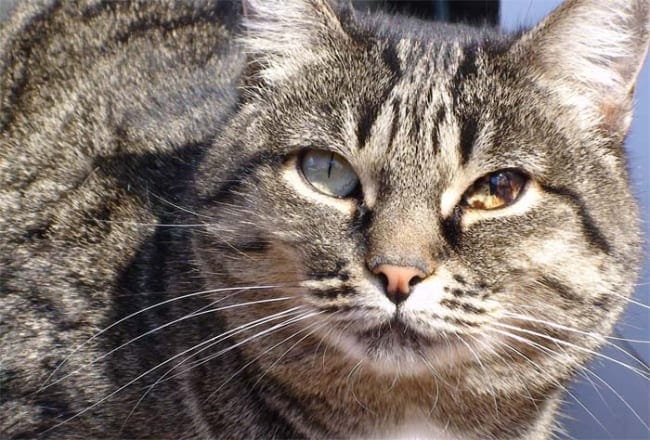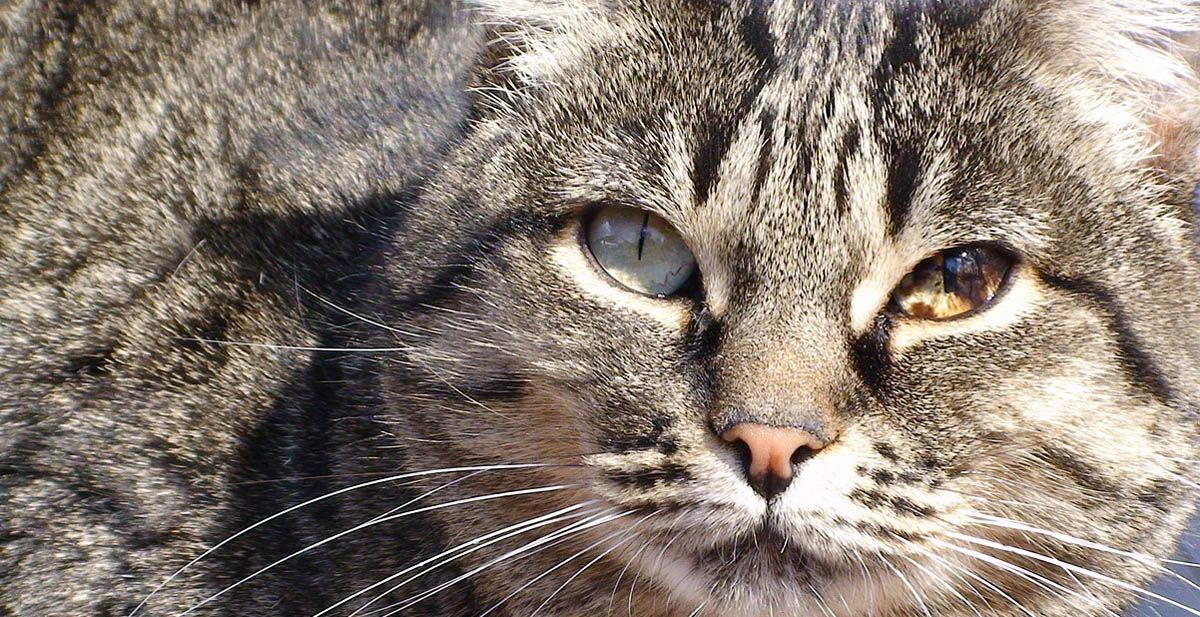At a glance
|
What are brown spots in a cat’s eye?
Medically known as iris melanosis, this condition appears as brown spots or areas of darker pigmentation on the anterior surface of the iris (the coloured part of the eye). Iris freckle is a layman’s term that may also be used to describe the condition.
Dark spots can develop in cats of any eye colour and may be cancerous (malignant) or benign. For the sake of simplicity, we will refer to the benign form as iris melanosis and the cancerous form as malignant melanosis.
Iris melanosis is caused by the increased proliferation of melanocytes (cells responsible for the production of pigmentation) across the surface of the iris. In rare cases, benign iris melanosis can transform into malignant melanoma if the cells undergo malignant transformation. More often than developing a malignancy, iris melanomas can cause glaucoma, a condition caused by increased pressure within the eyeball. Glaucoma causes distorted vision and can be extremely painful. Malignant melanomas have the potential to metastasize to the lungs, liver and other parts of the body.
Appearance
These lesions are focal or multifocal areas of dark brown pigmentation within the iris, which start out pale but progressively darken. Iris melanosis is commonly unilateral; however, both eyes can be affected. Spots may start small and gradually increase in size and pigmentation. Where multiple spots are present, as they grow in size, they may coalesce. Iris melanosis is flat and should not protrude above the surface of the iris. Malignant melanomas are often lumpy and raised and can cause distortion to the surface of the eye.
While iris melanosis is not painful for the cat, if infiltration of the neighbouring drainage angle occurs, glaucoma, an extremely painful increase in intraocular pressure, can develop. Iris melanosis may also cause the retina to detach.
Top causes of brown spots on the eye in cats:
- The majority of brown spots in the eyes of cats are caused by benign iris melanosis. The next most likely cause is malignant melanoma. Corneal sequestrums can be pigmented but appear much different than melanosis and melanoma and are formed by the cornea, not the iris.
Is iris melanosis painful for cats?
- No, iris melanosis is a benign condition and is not painful.
When to see a veterinarian
Any changes to a cat’s eye should be evaluated by a veterinarian as soon as possible. The veterinarian will perform a complete physical examination and obtain a medical history from you, including how long the spots have been present and any accompanying signs.
Differential diagnosis:
Iris melanosis isn’t the only cause of brown spots in the cat’s eye, and the veterinarian needs to rule out other causes before a definitive diagnosis is made.
Malignant melanoma – A cancer of the melanocytes (pigment-producing cells).
Feline corneal sequestrum – Brown or black plaques which develop on the eye due to parts of the cornea dying off. The most common causes are prolonged trauma due to eyelid abnormalities or infectious diseases. Unlike iris melanosis, feline corneal sequestrums are painful and can affect vision. There is a higher incidence of corneal sequestrums seen in Burmese, Persians, and British Shorthairs.
Diagnostic workup:
- Slit-lamp examination: This is an examination of the front of the eye using a slit-lamp, which is an instrument consisting of a high-intensity light, and a biomicroscope.
- Fine needle biopsy: A fine-gauge needle is inserted into the pigmented area and the plunger is pulled back to suction to remove a sample for microscopic evaluation to determine if the lesion is benign or cancerous.
The veterinarian may refer your cat to a veterinary ophthalmologist to confirm the diagnosis.
Does Iris Melanosis spread?
- The spots on the cat’s iris may get larger and small spots may coalesce into larger areas of pigmentation. One eye or both may be affected and enlarging lesions can lead to complications.
Treatment

- Treatment will be highly dependent on the diagnosis. For iris melanosis, a wait-and-see approach is often recommended. A follow-up exam with your veterinarian every six months is indicated to make sure the iris melanosis isn’t transforming into malignant melanoma. The veterinarian will take comparison photographs to check the size of the melanoma.
- If the cat suffers from malignant melanosis, destruction of the cells with a laser or removal of the entire eye (enucleation) will be necessary.
Is Iris Melanosis fatal in cats?
- Iris melanosis is a benign condition that is not fatal. If not watched closely, however, it can lead to serious and painful complications such as glaucoma and detachment of the retina.
Frequently asked questions
What is a melanoma of the eye?
- Malignant melanoma of the eye is a cancer of the pigment-producing cells of the iris. Though it may be hard to differentiate melanoma from melanosis, a trained veterinarian can often tell due to the color of the spot on the iris, whether the iris is distorted, if there is glaucoma present, and if there are stray cells seen floating in the anterior chamber. Many times a biopsy must be performed.
How common is iris melanoma?
- There are different types of melanomas in the eyes of cats, and each has its own likelihood of occurrence. However, iris melanoma is the most common eye tumor in cats.
Will the brown spots of melanosis go away on their own?
- The brown pigmented areas seen with benign iris melanosis do not typically resolve. If they stay static, they are unlikely to cause issues for the cat, but if they enlarge and spread, secondary complications such as glaucoma and retinal detachment may occur.


